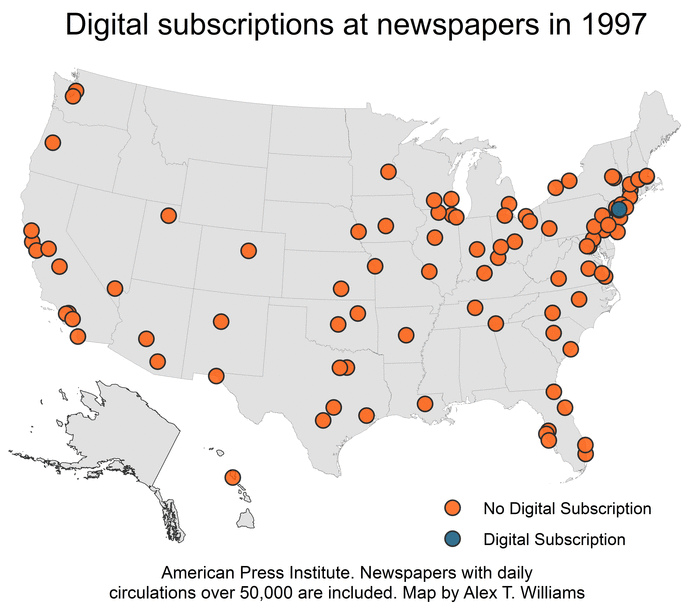Newspaper publishers in the United States have moved rapidly in recent years to create subscriptions for digital access to their news, and according to an in-depth analysis the landscape is converging around a couple leading models and price structures.
As the traditionally dominant revenue streams of print and advertising come under pressure, almost all newspapers are looking to their readers to contribute more. As of 2015, 77 of the 98 papers we examined have some form of a digital subscription plan that requires readers to pay for unlimited online access.
Seventy-one of those 77 have been launched within the past 5 years.
This exponential growth would have seemed unfathomable in 2009. Publications like The Guardian, The New York Times, Time Magazine and The Atlantic published op-eds questioning whether readers would be willing to pay for news online — and whether digital subscriptions would cause steep losses in readership and digital advertising.
As an American Press Institute research fellow, I catalogued and examined how newspapers are handling the push toward digital subscriptions. This analysis is based on independently gathering data about the models, launch dates and prices for digital subscriptions at U.S. newspapers. To make this detailed data-gathering manageable, we chose to include all newspapers with total circulations over 50,000 (a universe of 98 newspapers).[ref To identify newspapers with circulations over 50,000, this report used the Alliance for Audited Media’s (AAM) Monday – Friday total average circulation figures for the six months ended September 2014. These figures include print, digital, and branded editions. Based on AAM’s disclaimer that seven newspapers no longer report 5-day averages but typically had circulations in the top 25 in previous reports, those seven newspapers were also included in the analysis.]
The data is supplemented by interviews with news executives and a review of literature from academic and industry analyses.
[pulldata stat=”78%” context=”of U.S. newspapers with circulations over 50,000 are using a digital subscription model” align=”right”]What follows in this report is a comprehensive assessment of the state of digital subscriptions at U.S. papers.
This report shows how digital subscription models vary, by factors such as circulation size, geographic location, and ownership. It shows and explains newspapers’ rapid adoption of digital subscriptions and how the models and price points have evolved. The analysis identifies clear trends, diverging strategies, missed opportunities, and key questions about the future of digital subscriptions for the newspaper industry.
Among the study’s findings:
- 78% of U.S. newspapers with circulations over 50,000 are using a digital subscription model
- More specifically, 63% of the newspapers are using a metered model, 12% are using a freemium model, and 3% are using a hard model
- The average weekly price of a digital subscription for newspapers varies by type of model: $2.97 for meters; $3.52 for freemium; and $4.43 hard models
- The median number of free articles allowed by a metered model is 10 a month
- Digital subscription plans are relatively less common at the largest papers. (86% of newspapers with a daily circulation between 50-100k use a digital subscription plan; 64% of the newspapers with circulations over 250k do so.)
- Meter models are most prevalent in the Southeast (83%) and least common in the Southwest (45%)
- Freemium models are 3 times more popular in the Southwest (36% of newspapers) than in any other region
- Newspapers in the Northeast and Central United States tend to have higher digital subscription prices than those in other regions
- Publishers seem divided on whether to charge extra to add Sunday print delivery to a digital subscription: 37 newspapers charged more for that, 25 newspapers charged less, and 13 newspapers charged the same price
- When registering, new digital subscribers are not asked to provide information about their interests or demographics at any of the 77 newspapers with subscriptions
- Innovative experiments include “survey walls,” the “public radio funding model,” micropayments, the Washington Post’s partner program, and “iTunes for news.”
The potential revenue generated by digital subscriptions is still murky at best. It is not clear whether digital subscriptions were mostly a “one-time” cash infusion that simply capitalized on the most loyal digital readers who were always willing to pay or if newspapers will be able to consistently persuade more people to sign up in years to come. Newspaper executives are hesitant to disclose financial details about digital subscriptions.
The following chapters dive deeper into explaining the current state of digital subscriptions, what has changed in recent years, the early origins, the data gathered (or not) about subscribers, and more:
[newsletter]Share with your network
- How digital subscriptions work at newspapers today
- Early digital subscription models
- Experiments and future models for digital news subscriptions
- Publishers miss opportunity to collect data when registering subscribers
- How digital subscriptions took over the newspaper industry
- Paying for Digital News: The rapid adoption and current landscape of digital subscriptions at U.S. newspapers
You also might be interested in:
Successfully and efficiently marketing your work can be hard, especially for local news teams with limited resources, but marketing yourself to your audience is an essential skill for news organizations to drive revenue and promote sustainability.
As news teams begin thinking about their election coverage plans, it may feel like adding more tasks to an already full plate, with a fraction of the staff and resources they once had. But that doesn’t have to mean figuring out how to do more with less — maybe it’s doing less with less.
We reached out to Danielle Coffey, the CEO of American Press Institute’s parent corporation, the News/Media Alliance, to learn more about the legal fight for news organizations’ rights with AI.



